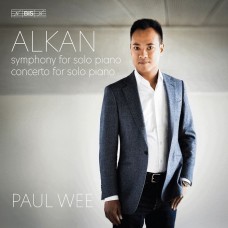|
阿爾肯:獨奏鋼琴協奏曲(第8-10號,作品39)與獨奏鋼琴交響曲(第4-7號,作品39)
魏保羅 鋼琴
2019年11月英國留聲機雜誌當月最佳古典新片之一
阿爾肯以鋼琴師身分在十九世紀的巴黎成名, 而且事業前途看好. 但是在一連串的挫折後, 使他退縮並過著隱居的生活. 當他從大眾的眼光消失後, 他的音樂也跟著消失了. 他的音樂並未完全被遺忘, 到了1960,70年之間, 他的作品從被忽略中逐漸重現. 鋼琴家魏保羅在CD小冊解說中說:”阿爾肯的音樂呈現一種對型式與結構令人敬畏的掌握, 強力的運用旋律, 高度的戲劇感和前所未見的鋼琴演奏能力.” 在此專輯中也許是首度將阿爾肯的兩件巔峰作品(給鋼琴獨奏的交響曲與協奏曲)一起錄製. 這四個樂章的交響曲和三個樂章的協奏曲通常是以七首練習曲形式被包含在阿爾肯1857年完成的(完全以小調演奏的十二首練習曲),作品39號. 至於為何他寫了這些史詩般作品後卻又將其藏在一組練習曲中, 魏保羅認為這些作品是應該被認為是”鋼琴與其演奏能力的一種慶祝”.
魏保羅是位專精於商業法的律師, 經常代表政府, 公司, 金融機構或個人等客戶出庭應訊. 他出生於澳大利亞, 四歲開始學習鋼琴, 之後在紐約曼哈頓音樂學校繼續深造. 在牛津大學唸法律系時, 他在喜愛的鋼琴和繁忙的國際法律業務需求之中保持平衡並進.
Paul Wee, piano
Charles-Valentin Alkan made his name as pianist in nineteenth-century Paris and seemed poised for a glittering career. But following a series of setbacks he withdrew into a life of relative seclusion, and as he receded from the public eye, so too did his music. It was never entirely forgotten, but it was not until the 1960s and 1970s that Alkan'sworks began to emerge from obscurity. To quote the liner notes by Paul Wee, ‘Alkan's music exhibits a formidable grasp of form and structure, a strong command of melody, a high sense of drama and an unprecedented exploitation of the capabilities of the piano.' Combined here on one disc –possibly for the first time –are the Symphony and the Concerto for Solo Piano, two pinnacles of Alkan'slegacy. Unusually, the four movements of the Symphony and the three movements of the Concerto are included as seven etudes within Alkan's Douze Études dans tous les tons mineurs (Twelve studies in all the minor keys), in 1857 as his Op. 39. As to why Alkan composed these epic works and then hid them away in a set of etudes, Wee suggests that they are to be seen as ‘a celebration of the piano and its capabilities.'
Paul Wee is a barrister specialising in commercial law and appears regularly before courts and tribunals on behalf of clients including governments, corporations, financial institutions and individuals. Born in Australia, he began his piano studies at the age of four, continuing them in New York City at the Manhattan School of Music. Going on to study law at the University of Oxford, he attempts to balance his love for the piano alongside the demands of a busy international career in law.
Charles-Valentin Alkan (1813—88)
Symphony for Solo Piano 26'16 Nos 4—7 of Douze etudes dans tous les tons mineurs, Op. 39
1 ) I. Allegro 10'33
2 ) II. Marche funebre. Andantino 6'19
3 ) III. Menuet 4'59
4 ) IV. Finale. Presto 4'08
Concerto for Solo Piano 51'30 Nos 8—10 of Douze etudes dans tous les tons mineurs
5 ) I. Allegro assai 29'59
6 ) II. Adagio 12'26
7 ) III. Allegretto alla barbaresca 8'56
TT: 78'32 |
|
|



